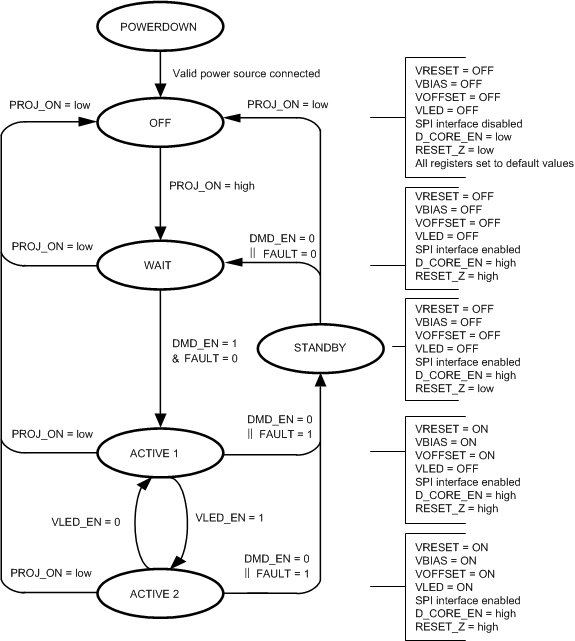ZHCSIA7 May 2018 DLPA4000
PRODUCTION DATA.
- 1 特性
- 2 应用
- 3 说明
- 4 修订历史记录
- 5 Pin Configuration and Functions
- 6 Specifications
-
7 Detailed Description
- 7.1 Overview
- 7.2 Functional Block Description
- 7.3
Feature Description
- 7.3.1 Supply and Monitoring
- 7.3.2 Illumination
- 7.3.3 External Power MOSFET Selection
- 7.3.4 DMD Supplies
- 7.3.5 Buck Converters
- 7.3.6 Auxiliary LDOs
- 7.3.7 Measurement System
- 7.4 Device Functional Modes
- 7.5 Programming
- 7.6 Register Maps
- 8 Application and Implementation
- 9 Power Supply Recommendations
- 10Layout
- 11器件和文档支持
- 12机械、封装和可订购信息
7.4 Device Functional Modes
Table 4. Modes of Operation
| MODE | DESCRIPTION |
|---|---|
| OFF | This is the lowest-power mode of operation. All power functions are de-energized, registers are reset to their default values, and the IC does not respond to SPI commands. RESET_Z pin is pulled low. The IC enters OFF mode whenever the PROJ_ON pin is low. |
| WAIT | The DMD regulators and LED power (VLED) are turned off, but the IC does respond to the SPI. The device enters WAIT mode whenever PROJ_ON is set high, DMD_EN(1) bit is set to 0 or a FAULT is resolved. |
| STANDBY | The device also enters STANDBY mode when a fault condition is detected(2). (See also section Interrupt). Once the fault condition is resolved, WAIT mode is entered. |
| ACTIVE1 | The DMD supplies are enabled but LED power (VLED) is disabled. PROJ_ON pin must be high, DMD_EN bit must be set to 1, and ILLUM_EN(3) bit is set to 0. |
| ACTIVE2 | DMD supplies and LED power are enabled. PROJ_ON pin must be high and DMD_EN and ILLUM_EN bits must both be set to 1. |
(1) Settings can be done through register 0x01
(2) Power-good faults, over-voltage, over-temperature shutdown, and undervoltage lockout
(3) Settings can be done through register 0x01, bit is named ILLUM_EN
Table 5. Device State as a Function of Control-Pin Status
| PROJ_ON Pin | STATE |
|---|---|
| LOW | OFF |
| HIGH | WAIT
STANDBY ACTIVE1 ACTIVE2 (Device state depends on DMD_EN and ILLUM_EN bits and whether there are any fault conditions.) |

A. || = OR, & = AND
B. FAULT = Undervoltage on any supply, thermal shutdown, or UVLO detection
C. UVLO detection, per the diagram, causes the DLPA4000 to go into the standby state. Standby state is not the lowest power state. If the application requires lower power, set PROJ_ON low.
D. DMD_EN register bit can be reset or set by SPI writes. DMD_EN defaults to 0 when PROJ_ON goes from low to high and then the DLPC4422 software automatically sets it to 1. Also, FAULT = 1 causes the DMD_EN register bit to be reset.
E. D_CORE_EN is a signal internal to the DLPA4000. This signal turns on the VCORE regulator.
Figure 18. State Diagram